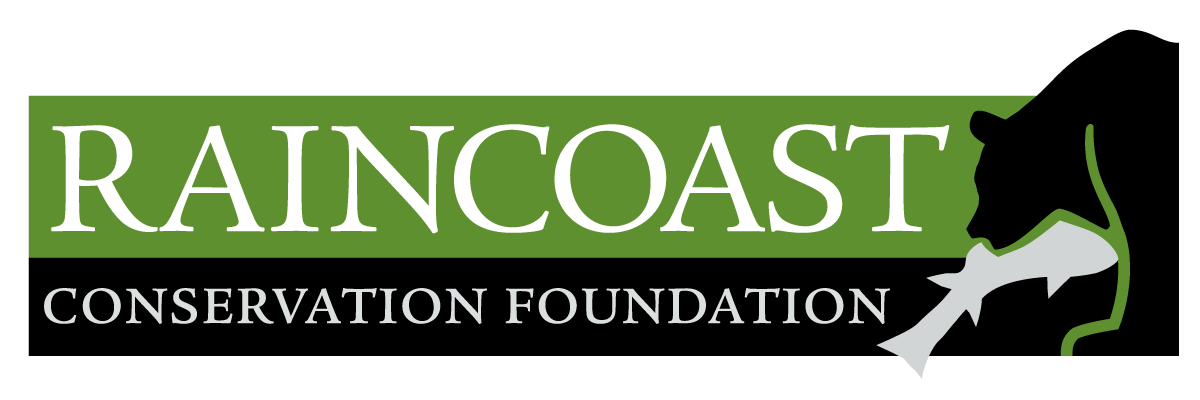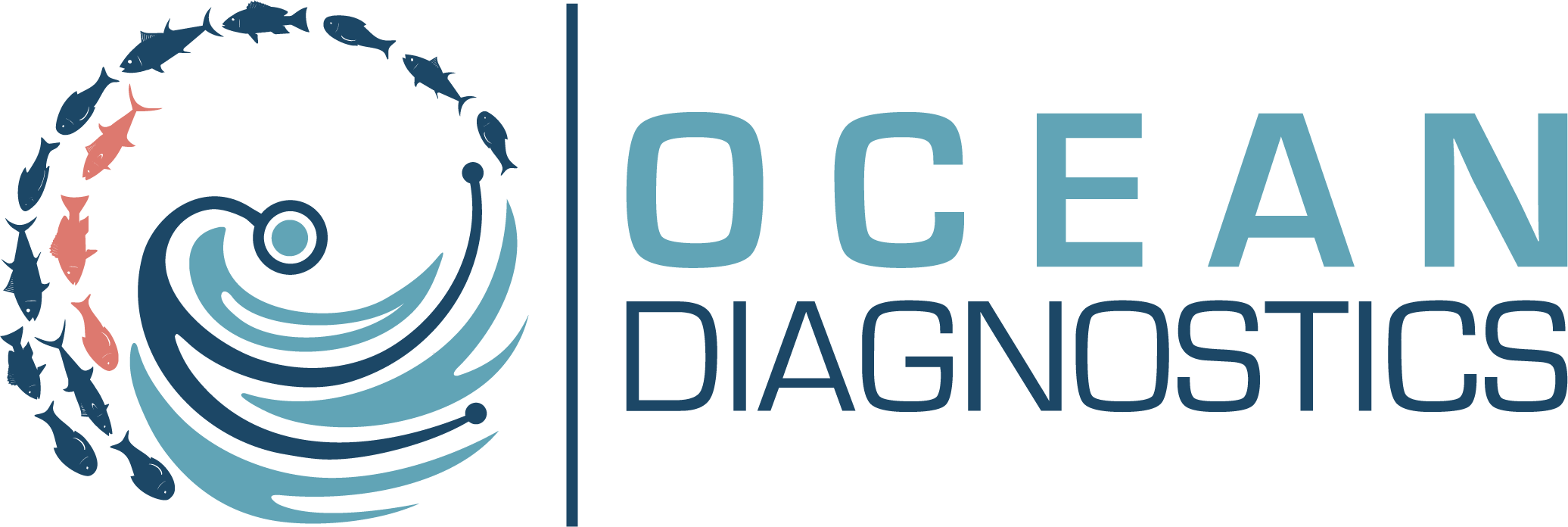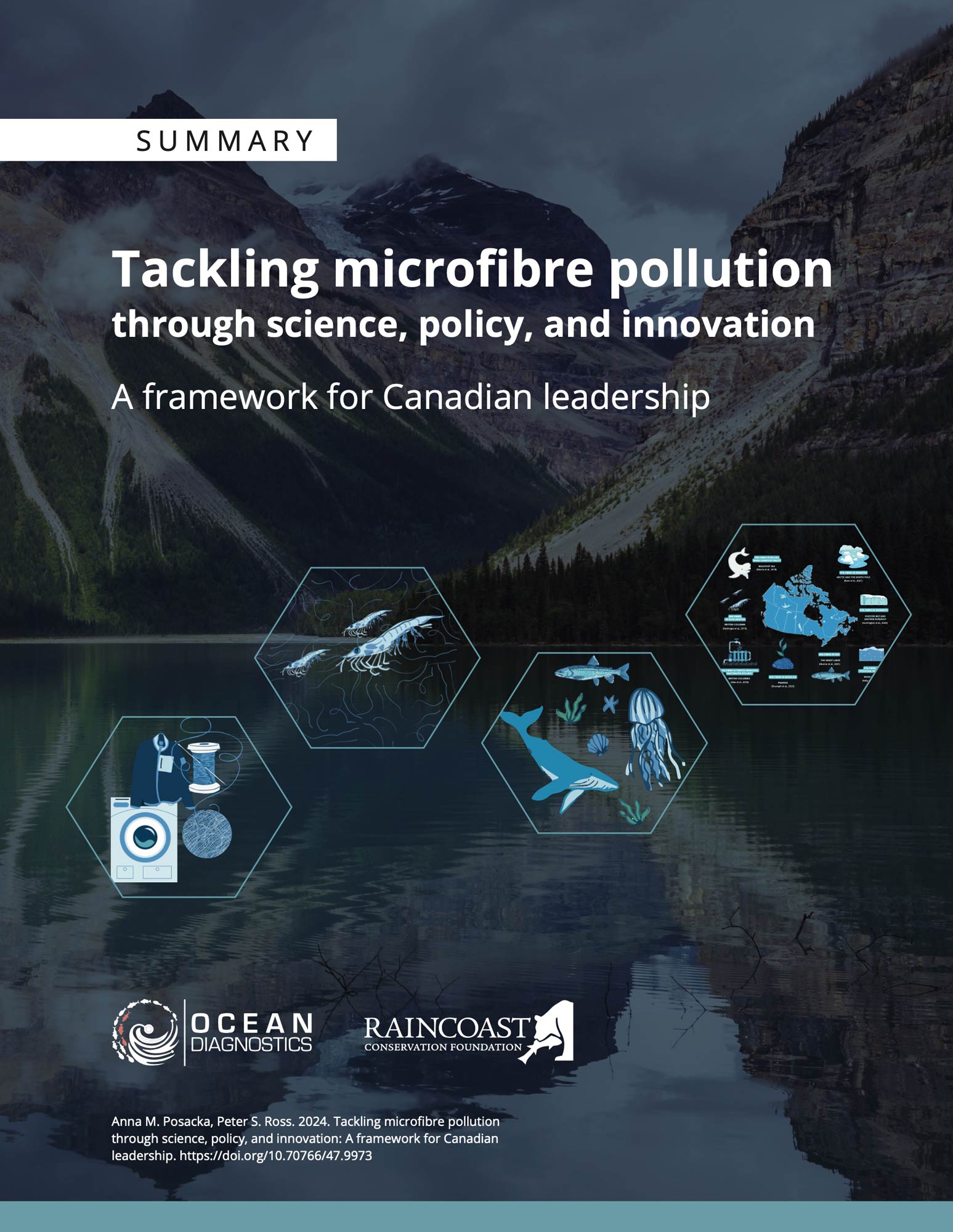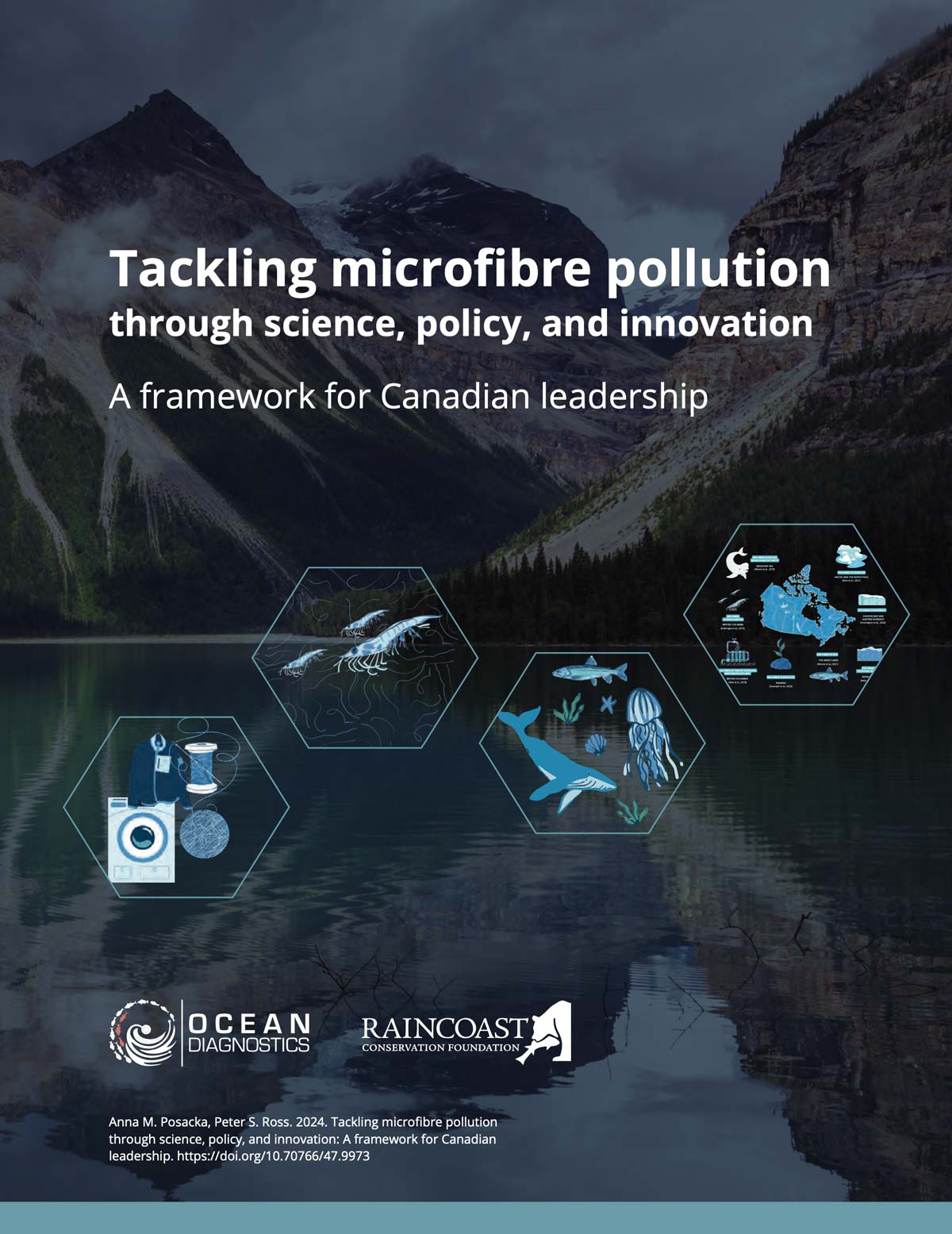Tackling microfibre pollution through science, policy, and innovation
A framework for Canadian leadership
Published on 2024 November 25.
Anna Posacka, Peter Ross. 2024. Tackling microfibre pollution through science, policy, and innovation: A framework for Canadian leadership. https://doi.org/10.70766/47.9973
Prepared by
Anna M. Posacka, Strategic Advisor
Ocean Diagnostics Inc | About | Microplastics pollution | More about the report
Peter S. Ross, Senior Scientist
Raincoast Conservation Foundation | Healthy Waters
This comprehensive report, alongside a summary report, was made possible through the financial support of Environment and Climate Change Canada.

Executive summary
Microfibre pollution has emerged as a global conservation and public health concern, prompting a wave of research related to its source, transport, fate and effects, as well as mitigation strategies. This report provides support for the Government of Canada in decision-making on microfibres, by summarizing important elements of the topic from the scientific literature, stakeholder consultations and cross-sector activities. The goal herein is to characterize the primary sources, discharge mechanisms and environmental fate of microfibre pollution in Canada, review available methodologies and definitions, list candidate solution strategies for Canadian application, and review global advances in policy and industry.
Many sources and types of microfibres exist, but current evidence suggests that environmental microfibre contamination originates largely from the textile sector, with releases arising during manufacturing, trade and laundry processes. Two broad categories of textiles in this sector are relevant to the characterisation of sources, applications and processes that result in microfibre pollution in Canada, namely conventional (clothing) and technical textiles. We focus herein on conventional textiles, as a significant, but not exclusive, source of microfibres to the Canadian environment. Additional types of products that contribute microfibres to the environment are those used in the fishing, civil engineering, medical, personal care and construction sectors, and consumer products such as cigarettes. The underlying polymers used in these products can be both synthetic and natural, with both being the focus of this report.
Our awareness of microfibre pollution grew out of the broader research on microplastics. This research demonstrates that microfibres, often the dominant type of microplastics, are pervasive in the environment, wildlife and drinking water. In Canada, microfibres account for approximately 80 per cent of the microplastic particles reported across water, soil, biota, air, and wastewater samples. While Canadian researchers will continue to benefit from new approaches to the sampling, detection and identification of microfibres and microplastics in the environment, having comparable data among studies and monitoring programs is crucial. Agreed-upon Quality Assurance/Quality Control (QA/QC) protocols are needed by producers, researchers, natural resource managers, consultants and regulators. This report assesses progress in the important, but at times challenging developments in the standardization and harmonization of microfibre methods, and provides guidance for stakeholders on best scientific and technical practices and the latest measurement methods.
Microfibre pollution arising from textiles is a multifaceted environmental challenge that cannot be effectively mitigated through technical solutions alone. Meaningful and lasting reductions in microfibre pollution will require a holistic approach that recognizes the interconnected role of the textile value chain and the ways in which microfibres contaminate the environment. Such a system prioritizes waste reduction and waste management at all stages.
Achieving a demonstrable reduction in microfibre pollution in the environment necessitates a re-evaluation and transformation of how textiles are designed, produced, used, and disposed of, ensuring sustainability is embedded at every stage. While domestic circumstances in Canada offer the most immediate regulatory and policy solution opportunities, a dual approach that helps to also capture the international supply chain is critical to the success of efforts to curtail microfibre pollution in the Canadian environment.
Microfibre pollution is but one – albeit important – environmental impact associated with the textile sector. We therefore touch herein on additional impacts that may be considered so as to maximize sustainability aims and the protection of human health. A systems change approach will allow Canada to achieve wider environmental goals around the textile sector, such as reducing plastic and microfibre pollution, conserving water and energy resources, reducing the release of potentially harmful dyes and additives, reducing greenhouse gas emissions, and ultimately minimizing the overall ecological footprint of our clothing choices.
Key findings
- Microfibres are widespread global contaminants that threaten the health of Canadians and the environment. The scientific evidence is clear: there is a significant release of microfibres into the Canadian environment. Concerns about microfibres include their environmental persistence, complex interactions in the environment, and potential to harm human and environmental health. In Canada, microfibres account for approximately 80% of microplastic particles detected across water, soil, biota, air, and wastewater samples. Canada can serve as an international leader for microfibre pollution science, by enabling advanced research on the release, fate and effects of microfibres, and emphasizing comparable sampling methods, analytical processing, and data processing protocols.
- Microfibre releases remain largely uncontrolled and unregulated. Limited regulatory and policy actions today reflect the very recent discovery of microplastics and microfibres as notable environmental and public health concerns, and virtual lack of effective monitoring initiatives. This is in part due to gaps in standardized methodologies, emerging understanding of exposure and effects, and challenges in conducting human and ecological risk assessments for these novel contaminants. However, significant advances internationally have resulted in suitable methods and tools needed to quantify and characterise the releases and environmental concentrations of microfibres. Furthermore, some jurisdictions have started to formulate or implement strategies and regulations aimed at reducing microfibre releases. Canada should develop a national approach that acquires insights from domestic and international experiences, and initiate a multi-sector / multi-agency approach that is meaningful and trackable.
- Microfibres are generated across the lifecycle of textile materials used for clothing. Estimates from scientific and grey literature suggest that global apparel manufacturing contributes 0.12 million tonnes of microfibres, while domestic and commercial laundry between 0.018-0.53 million tonnes of microfibres to the environment each year. Significant amounts of microfibres are thought to be released from electrical drying and everyday clothing wear, but data availability is limited. Our analysis reveals significant microfibre pollution contributions to the Canadian environment through:
- Homes: Canadian households generate approximately 1,920 tonnes of microfibres annually.
- Wastewater: 264 tonnes of microfibres pass through wastewater treatment facilities and enter water bodies, with an additional 35 tonnes entering waterways as untreated wastewater.
- Biosolids: 1,621 tonnes of microfibres accumulate in biosolids every year in Canada. The land application of these biosolids in agriculture and land reclamation practices spreads an estimated 795 tonnes of microfibres onto Canadian soils each year.
- Commercial laundry: Preliminary estimates suggest that commercial laundry operations could be releasing up to 1,099 tonnes of microfibres annually.
- Textile manufacturing: there is insufficient data to evaluate microfibre releases from textile manufacturing processes in Canada, underscoring the need for further research.
By 2030, the laundering of textiles is projected to contribute 6,558 tonnes of microfibres to the Canadian environment, marking a critical timeline for Canada’s ambitious zero plastic waste objectives. This is equivalent to over 44 million T-shirts.
A microfibre pollution reduction blueprint for Canada
- Innovation in textile design and production techniques can reduce microfibre releases by industry and by consumers both in Canada and internationally. Standards or guidelines for environmentally-friendly textile design and manufacturing represent one of the key ways to achieve reductions in microfibre releases from Canadian sources. Since the majority of textile products sold in Canada are imported, Canadian fashion brands and retailers have an important role to play in driving innovation in practices and processes needed to protect the Canadian environment from microfibre contamination. This report consolidates the latest technical solutions and strategic approaches that have the potential to transform textile industry practices, and reduce its contribution to microfibre pollution.
- Widespread washing machine filtration could result in a dramatic reduction (up to 90%) in microfibre discharges from domestic and commercial wastewater effluent in Canada. Evidence from scientific studies of aftermarket devices underscores the effectiveness of this measure. Recent policy and regulatory initiatives introduce mandatory filtration in new washing machines to reduce microfibre pollution. Promotion of best practices for product care and further innovation by appliance manufacturers to minimize microfibre releases during laundry can offer additional benefits towards mitigating the issue.
- Electrical drying of clothing represents a relatively recent concern, with research pointing to significant releases of microfibres into the air. The majority of Canadian households utilize electrical drying for laundry, underscoring the need for targeted solutions, such as improved lint capture and consumer education.
- The accumulation of microfibres in biosolids, with the subsequent release into terrestrial ecosystems through land application, underscores the potential for significant and widespread distribution of microfibres in agricultural, forestry and land reclamation areas. Reductions in liquid waste microfibre content through source control practices (as above), and new approaches to biosolids processing should be explored.
- A national textile circularity and sustainable fashion strategy, with an emphasis on reducing overproduction and combating microfibre pollution, should be a top priority for Canada. Such a strategy would position Canada alongside a growing cadre of nations actively developing or implementing circular textile initiatives. Enhancing the utilization and durability of our clothing and lowering the demand for new products indirectly contributes to microfibre pollution mitigation.
- Increasing awareness amongst industry players and the public. There continues to be a lack of fulsome awareness of what microfibres are, where they come from, and what we can do about them across Canadian sectors. Clear, concise and widely available information on the topic would enable solution-oriented actions at all levels in Canada and contribute to the ‘team approach’ required to fix the microfibre problem.
- Advancing knowledge through research and collaborative initiatives will enhance data availability, build consensus and contribute to decision-making across the board. Leadership through Ottawa will not only aid in a better understanding of the stakes, but would also position Canada as the leader in the global effort to combat microfibre pollution.
Acknowledgements
We would like to thank Marie Noël, Liliane Stewart, Sean Yang, Iselle Flores, Sherwin Arnott, Alex Harris and Ashleigh Erwin for contributing to this report. We would also like to thank Anne Clarisse Ndjou’ou, Vanessa Evans, Joel Chung and Eric Corneau at ECCC for their valuable project input.
We are grateful for the expert reviews and inputs from the following:
- Farida Bishay, Metro Vancouver
- Kelly Drennan, Fashion Takes Action
- Lisa Erdle, 5Gyres
- Douglas Gilliand, EU Joint Research Centre
- Joel Mertens, Cascale
- Rhiannon Moore, City of Victoria
- Catrin Norris, Flora & Fauna
- Chelsea Rochman, University of Toronto
Jesse Vermaire, Carleton University



